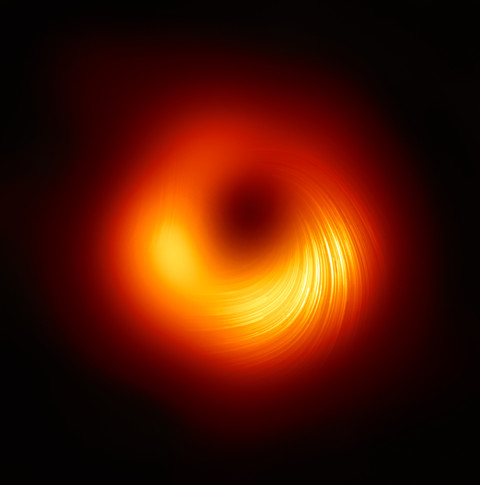The Event Horizon Telescope (EHT) collaboration, who produced the first ever image of a black hole, has revealed today a new view of the massive object at the centre of the M87 galaxy: how it looks in polarised light. This is the first time astronomers have been able to measure polarisation, a signature of magnetic fields, this close to the edge of a black hole. The observations are key to explaining how the M87 galaxy, located 55 million light-years away, is able to launch energetic jets from its core.
“We present an image of M87*, the supermassive black hole at the centre of the galaxy M87, in polarised light”, says Laurent Loinard, of the Instituto de Radioastronomía y Astrofísica (IRyA), at the Morelia Campus of UNAM, in Mexico. “It is a bit like seeing the balck hole with sunglasses. This allows to determine the intensity and direction of the magnetic field at the scales of the M87* event horizon.”
“We are now seeing the next crucial piece of evidence to understand how magnetic fields behave around black holes, and how activity in this very compact region of space can drive powerful jets that extend far beyond the galaxy,” says Monika Mościbrodzka, Coordinator of the EHT Polarimetry Working Group and Assistant Professor at Radboud Universiteit in the Netherlands.
On 10 April 2019, scientists released the first ever image of a black hole, revealing a bright ring-like structure with a dark central region — the black hole’s shadow. Since then, the EHT collaboration has delved deeper into the data on the supermassive object at the heart of the M87 galaxy collected in 2017. They have discovered that a significant fraction of the light around the M87 black hole is polarised.
“This work is a major milestone: the polarisation of light carries information that allows us to better understand the physics behind the image we saw in April 2019, which was not possible before,” explains Iván Martí-Vidal, also Coordinator of the EHT Polarimetry Working Group and GenT Distinguished Researcher at the Universitat de València, Spain. He adds that “unveiling this new polarised-light image required years of work due to the complex techniques involved in obtaining and analysing the data.”
“The image of M87* allows to test Albert Einstein’s theory of General Relativity. To do that, however, we need to understand better the properties of the gas surrounding the black hole”, continues Laurent Loinard. “The observations reported here allow to clearly distinguish between different possible descriptions or models of this gas, which is a fundamental step towards using EHT images to test General Relativity.”
Light becomes polarised when it goes through certain filters, like the lenses of polarised sunglasses, or when it is emitted in hot regions of space that are magnetised. In the same way polarised sunglasses help us see better by reducing reflections and glare from bright surfaces, astronomers can sharpen their vision of the region around the black hole by looking at how the light originating from there is polarised. Specifically, polarisation allows astronomers to map the magnetic field lines present at the inner edge of the black hole.
“The newly published polarised images are key to understanding how the magnetic field allows the black hole to 'eat' matter and launch powerful jets,” says EHT collaboration member Andrew Chael, a NASA Hubble Fellow at the Princeton Center for Theoretical Science and the Princeton Gravity Initiative in the USA.
The bright jets of energy and matter that emerge from M87’s core and extend at least 5000 light-years from its centre are one of the galaxy’s most mysterious and energetic features. Most matter lying close to the edge of a black hole falls in. However, some of the surrounding particles escape moments before capture and are blown far out into space in the form of jets.
Astronomers have relied on different models of how matter behaves near the black hole to better understand this process. But they still don’t know exactly how jets larger than the galaxy are launched from its central region, which is as small in size as the Solar System, nor how exactly matter falls into the black hole. With the new EHT image of the black hole and its shadow in polarised light, astronomers managed for the first time to look into the region just outside the black hole where this interplay between matter flowing in and being ejected out is happening.
The observations provide new information about the structure of the magnetic fields just outside the black hole. The team found that only theoretical models featuring strongly magnetised gas can explain what they are seeing at the event horizon.
“The observations suggest that the magnetic fields at the black hole’s edge are strong enough to push back on the hot gas and help it resist gravity’s pull. Only the gas that slips through the field can spiral inwards to the event horizon,” explains Jason Dexter, Assistant Professor at the University of Colorado Boulder, USA, and coordinator of the EHT Theory Working Group.
To observe the heart of the M87 galaxy, the collaboration linked eight telescopes around the world to create a virtual Earth-sized telescope, the EHT. The impressive resolution obtained with the EHT is equivalent to that needed to measure the length of a credit card on the surface of the Moon.
This setup allowed the team to directly observe the black hole shadow and the ring of light around it, with the new polarised-light image clearly showing that the ring is magnetised. The results are published today in two separate papers in The Astrophysical Journal Letters by the EHT collaboration. The research involved over 300 researchers from multiple organisations and universities worldwide.
“The EHT is currently one of the most important scientific endeavours worldwide. The participation of Mexico in this project serves to give world visibility to Mexican science”, comments Laurent Loinard. “It also allows Mexican students and young researchers to be immersed in this exciting and vibrant collaboration, which involves some of the best scientists in the world. This is a really a global collaboration that lets people interact with scientists from many backgrounds and horizons. It is a very enriching experience to be a part of it.”
"The EHT is making rapid advancements, with technological upgrades being done to the network and new observatories being added. We expect future EHT observations to reveal more accurately the magnetic field structure around the black hole and to tell us more about the physics of the hot gas in this region," concludes EHT collaboration member Jongho Park, an East Asian Core Observatories Association Fellow at the Academia Sinica Institute of Astronomy and Astrophysics in Taipei.
Published images and other material
- Main image:Polarised emission of the ring in M87*
Caption:Polarised view of the black hole in M87*. The lines mark the orientation of polarisation, which is related to the magnetic field around the shadow of the black hole.
TIFF (10 Mb): https://owncloud.mpifr-bonn.mpg.de/index.php/s/cf7xSAnjtJHBgyK
JPG (8.8 Mb): https://owncloud.mpifr-bonn.mpg.de/index.php/s/Nbw5M57JHZ6yGzS
Credit: © EHT Collaboration
- Animation:Transition between the observed polarisation image and a best-fit theory image
GIF (7.6 Mb): https://owncloud.mpifr-bonn.mpg.de/index.php/s/3nLoNtAHiGdCK9r
Credit: © Monika Mościbrodzka & Sara Issaoun, Radboud Universiteit Nijmegen; EHT Collaboration
- Video:Zooming-in to the heart of M87
Caption:Journey to the interior of M87, including the polarised image of the ring around the central black hole
MP4 (81 Mb, 47 s): https://cdn.eso.org/videos/hd_1080p25_screen/eso2105b.mp4
Credit: © ESO/L. Calçada, Digitized Sky Survey 2, ESA/Hubble, RadioAstron, De Gasperin et al., Kim et al., EHT Collaboration. Music: Niklas Falcke
- Photograph:The EHT polarisation team
Caption:Group picture of the workshop which triggered the work on imaging the magnetic fields of M87*, at the Max-Planck-Institut für Radioastronomie in Bonn, Germany, on July 15-19, 2019. Dr. Laurent Loinard is the front line at the right, with a blue polo shirt.
JPG (7.8 Mb): https://owncloud.mpifr-bonn.mpg.de/index.php/s/xj2BgtKNe2fAD5a
Credit: © E. Traianou/MPIfR
- Video: EHT: Polarisation and magnetic fields around a black hole
Caption: Black holes are enveloped in plasma. This plasma has magnetic fields—areas where magnetism affects how matter moves—threaded throughout. As the magnetic field grows stronger, it changes shape and the polarized light we measure exhibits different patterns.
MP4 (English audio; 35.5 Mb): https://owncloud.mpifr-bonn.mpg.de/index.php/s/Jjypgq6Y6F3LxYT
Youtube (English audio): https://www.youtube.com/watch?v=6xrJoPjfJGQ
Youtube (English audio):https://youtu.be/A-w9elXt380
Credits: © EHT Collaboration y Crazybridge Studios
- Video:The M87* image as seen through a light polariser
Caption:The M87* image as seen through a light polariser
M4V (11.7 Mb): https://owncloud.mpifr-bonn.mpg.de/index.php/s/AgZ7EXmXjoeWLoM
Youtube: https://youtu.be/AU2qGTpMn8I
Credit: © Iván Martí, Universitat de València & EHT Collaboration
Published papers and related links:
- Paper VII: First M87 Event Horizon Telescope Results VII: polarization of the ring, The Astrophysical Journal Letters, 910, L12
http://doi.org/10.3847/2041-8213/abe71d
- Paper VIII: First M87 Event Horizon Telescope Results VIII: Magnetic Field Structure Near The Event Horizon, The Astrophysical Journal Letters, 910, L12
http://doi.org/10.3847/2041-8213/abe4de
- Related paper: Polarimetric properties of Event Horizon Telescope targets from ALMA (Goddi, Martí-Vidal, Messias, et al.)
http://doi.org/10.3847/2041-8213/abee6a
- EHT press release
https://eventhorizontelescope.org/blog/astronomers-image-magnetic-fields-edge-m87s-black-hole
Additional information about the ETH
This research was presented in two papers published today in The Astrophysical Journal.
The EHT collaboration involves more than 300 researchers from Africa, Asia, Europe, North and South America. The international collaboration is working to capture the most detailed black hole images ever obtained by creating a virtual Earth-sized telescope. Supported by considerable international investment, the EHT links existing telescopes using novel systems — creating a fundamentally new instrument with the highest angular resolving power that has yet been achieved.
The individual telescopes involved are: ALMA, APEX, the IRAM 30-meter Telescope, the IRAM NOEMA Observatory, the James Clerk Maxwell Telescope (JCMT), the Large Millimeter Telescope (LMT), the Submillimeter Array (SMA), the Submillimeter Telescope (SMT), the South Pole Telescope (SPT), the Kitt Peak Telescope, and the Greenland Telescope (GLT).
The EHT consortium consists of 13 stakeholder institutes: the Academia Sinica Institute of Astronomy and Astrophysics, the University of Arizona, the University of Chicago, the East Asian Observatory, Goethe-Universitaet Frankfurt, Institut de Radioastronomie Millimétrique (MPG/CNRS/IGN), Large Millimeter Telescope, Max Planck Institute for Radio Astronomy, MIT Haystack Observatory, National Astronomical Observatory of Japan, Perimeter Institute for Theoretical Physics, Radboud University and the Smithsonian Astrophysical Observatory.
Dr. Laurent Loinard's career
Dr. Laurent Loinard obtained a bachelor in Physics and a Master’s and PhD degrees from the Joseph Fourier University in Grenoble, France. In October 2000 he started working in Morelia at UNAM, where he is now a research scientist at the Institute of Radioastronomy and Astrophysics, IRyA. He is a member of the Event Horizon Telescope (EHT) collaboration. He currently is the head of UNAM’s Astrophysics postgraduate program, which incorporates several UNAM institutions at locations in Mexico City and Ensenada (Baja California), as well as Morelia.
EHT Collaboration contact in México:
Dr. Laurent Loinard
IRyA UNAM Campus Morelia
xm.manu.ayri@draniol.l
Media contact:
Dr. René A. Ortega Minakata
Outreach and Science Communication
IRyA UNAM Campus Morelia
xm.manu.ayri@agetro.r,
Original text: EHT Collaboration. Adapted by: IRyA UNAM. Text and additional material shared under a CC-BY-SA license.





